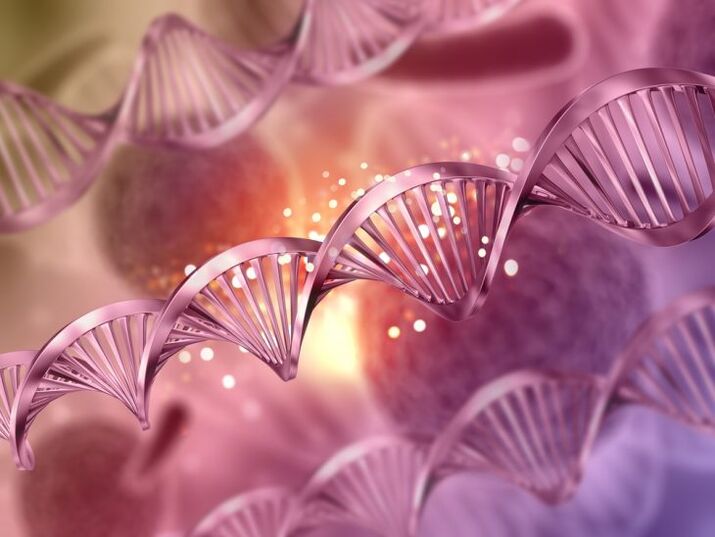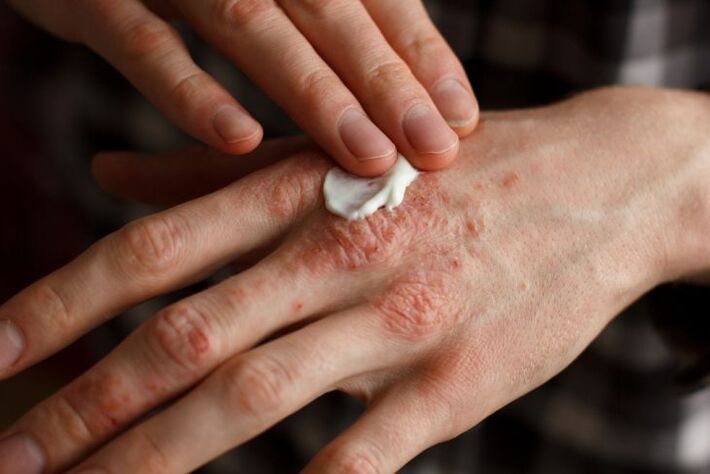Psoriasis, or squamous lichen, in children is a chronic disease that is manifested by the formation of silvery-white papules (bumps) on the child's skin. The incidence of psoriasis among all dermatoses is approximately 8%. This disease occurs in groups of children of different ages, including infants and newborns, most often in girls. The disease is characterized by a certain seasonality: in winter there are more cases of psoriasis than in summer.
The disease is not contagious, although the viral theory of its origin is still being considered.
Causes of the disease

The normal maturation cycle of skin cells is 30 days. In psoriasis, it is reduced to 4-5 days, which is manifested by the formation of psoriatic plaques. It was discovered by electron microscopy method that the same changes are present in the healthy skin of the child as in the affected areas. Also, in patients with psoriasis, a disruption in the functioning of the nervous, endocrine, immune systems, metabolism (mainly enzymatic and fatty) and other changes in the body are revealed. This suggests that psoriasis is a systemic disease.
There are three main groups of causes of psoriasis:
- inheritance;
- Wednesday;
- Infections
Heredity is a major factor in the development of psoriasis. This is confirmed by the study of dermatosis that occurs in twins, in relatives of several generations, as well as biochemical studies of healthy relatives. If one of the parents is sick, the probability that the child will get psoriasis is 25%, if both are sick - 60-75%. At the same time, the type of inheritance remains unclear and is recognized as multifactorial.
Environmental factors include seasonal changes, the contact of clothing with the skin, the impact of stress on the child's psyche, relationships with peers. Focusing the children's attention in a team on a sick child, treating them like a "black sheep", limiting contacts for fear of infection - all these factors can provoke new exacerbations, an increase in the area of skin lesions. A child's psyche is especially vulnerable during puberty, which is due to hormonal changes. Therefore, a large percentage of detection of the disease falls on adolescents.
The proportion of genetic and environmental factors that cause the appearance of psoriasis is 65% and 35%.
Infections trigger infectious-allergic response mechanisms that can trigger the development of psoriasis. So, the disease can occur after the transferred flu, pneumonia, pyelonephritis, hepatitis. Even the postinfectious form of the disease is distinguished. It is characterized by a profuse drop-shaped papular rash all over the body.
In some cases, the onset of psoriasis is preceded by skin trauma.
Symptoms
Psoriasis is characterized by the appearance on the skin of a rash in the form of islets ("plaques") that are red with silvery-white patches that easily peel and itch. The appearance of cracks in the plates can be accompanied by slight bleeding and is fraught with the addition of a secondary infection.
Externally, psoriatic rashes in children are similar to those in adults, but there are some differences. For children with psoriasis, Koebner syndrome is very characteristic - the appearance of rashes in areas affected by irritation or injury.
The course of childhood psoriasis is long, with the exception of a more favorable form of the tear-shaped disease. There are three stages of the disease:
- progressive;
- stationary;
- regressive.
The progressive stage is characterized by the formation of small itchy papules surrounded by a red border. Lymph nodes can become enlarged and thickened, especially in severe psoriasis. In the stationary stage, the growth of the rashes stops, the center of the plaques flattens, and the desquamation decreases. In the regression stage, the elements of the rash dissolve, leaving a depigmented rim (Voronov rim). The rash leaves hyper- or hypopigmented spots.
The location of psoriatic eruptions can be different. Most often, the skin on the elbows, knees, buttocks, navel, and scalp is affected. One in three children with psoriasis has affected nails (the so-called thimble symptom, in which small holes appear in the nail plates, resembling the fossa of a thimble). Plaques can often be found in the folds of the skin. The mucous membranes, especially the tongue, are also affected and the rash may change its location and shape ("geographic tongue"). The skin of the palms and the plantar surface of the foot is characterized by hyperkeratosis (thickening of the upper layer of the epidermis). The face is less likely to be affected, the rash appears on the forehead and cheeks, and may spread to the ears.
In the blood test, an increase in the amount of total protein and the level of gamma globulins, a decrease in the albumin-globulin coefficient, and violations of fat metabolism are detected.
Forms of childhood psoriasis
- drop-shaped
- license plate;
- pustular;
- erythrodermic;
- infant psoriasis;
- psoriasic arthritis.
The most common way istear-shaped psoriasis. . . It manifests itself in the form of red bumps on the body and extremities, which occur after minor injuries, as well as after infections (otitis media, rhinopharyngitis, flu, etc. ). In a throat swab, a cytological examination reveals streptococci. The teardrop form of psoriasis is often mistaken for allergic reactions.
Plaque psoriasis is characterized by red rashes with clear borders and a thick layer of white scales.
The pustular or pustular form of the disease is rare. The appearance of pustules can be caused by infections, vaccines, use of certain medications, stress. Pustular psoriasis that occurs in newborns is called neonatal.
With erythrodermic psoriasis, a child's skin looks completely red; some areas of the skin may have plaque. Often the skin manifestations are accompanied by an increase in body temperature and joint pain.
Pustular and erythrodermic psoriasis can take generalized forms with a severe course. They require hospital treatment to avoid death.
Infant psoriasis is also known as diaper psoriasis. It is difficult to diagnose because skin lesions occur most often in the buttock area and can be mistaken for dermatosis due to irritation of the skin with urine and feces.
Psoriatic arthritis affects approximately 10% of children with psoriasis. Joints swell, muscles stiffen, pain occurs in the toes, ankles, knees, wrist joints. Conjunctivitis is often associated.
Usually the course of any form of the disease changes every three months. In summer, due to sun exposure, the symptoms usually disappear.
Treatment

It is better to hospitalize a child with psoriasis for the first time.
- Desensitizing agents (5% calcium gluconate solution or 10% calcium chloride solution inside, 10% calcium gluconate solution intramuscularly) and sedatives (motherwort tincture, valerian) are prescribed.
- With severe itching, antihistamines and tranquilizers are appropriate.
- B vitamins are shown intramuscularly for 10-20 injections: B6 (pyridoxine), B12 (cyanocobalamin), B2 (riboflavin); inside: B15 (pangamic acid), B9 (folic acid), A (retinol) and C (ascorbic acid).
- To activate the body's defenses, drugs that have a pyrogenic property (that raise the temperature) are used. They normalize vascular permeability and reduce the rate of epidermal cell division.
- Weekly blood transfusions, the introduction of plasma and albumin are shown.
- If treatment is ineffective, as well as in severe cases of the disease, the doctor may prescribe glucocorticoids in a course of 2-3 weeks, with a gradual decrease in dosage and subsequent discontinuation of the drug. The dose is selected individually. Cytostatics are not prescribed to children due to their toxicity.
- To combat plaque on the palms and soles, occlusive (sealed) dressings with salicylic sulfur tar ointments are used.
- In the stationary and regressive stages of psoriasis, children are prescribed UFOs, sedative baths, and herbal medications. Sapropel extract, which is used in the form of applications or baths, has been tried.
With frequent colds that accompany psoriasis, it is necessary to disinfect the sources of infection: cure decayed teeth, perform deworming, if indicated, perform tonsillectomy and adenotomy. A desirable step in treating psoriasis is spa treatment.
Remember that psoriasis is a chronic disease characterized by periods of exacerbation and remission, and be prepared for regular and long-term treatment.
The child needs to instill a healthy lifestyle, teach him to cope with stress, calmly respond to the attacks of his peers. The situation is especially difficult with children whose facial skin is affected. All family members should support a sick child, which will help him avoid complexes and grow as a socially adapted person.
Which doctor to contact
Psoriasis in children is treated by a dermatologist. If not only the skin is affected, but also the joints, a consultation with a rheumatologist is indicated, with the development of conjunctivitis - an ophthalmologist. It is necessary to disinfect the foci of chronic infection by visiting a dentist, infectious disease specialist, otolaryngologist. If there are difficulties in the differential diagnosis of psoriasis and allergic diseases, you should contact an allergist. A nutritionist, physical therapist and psychologist assist in the treatment of the patient.























